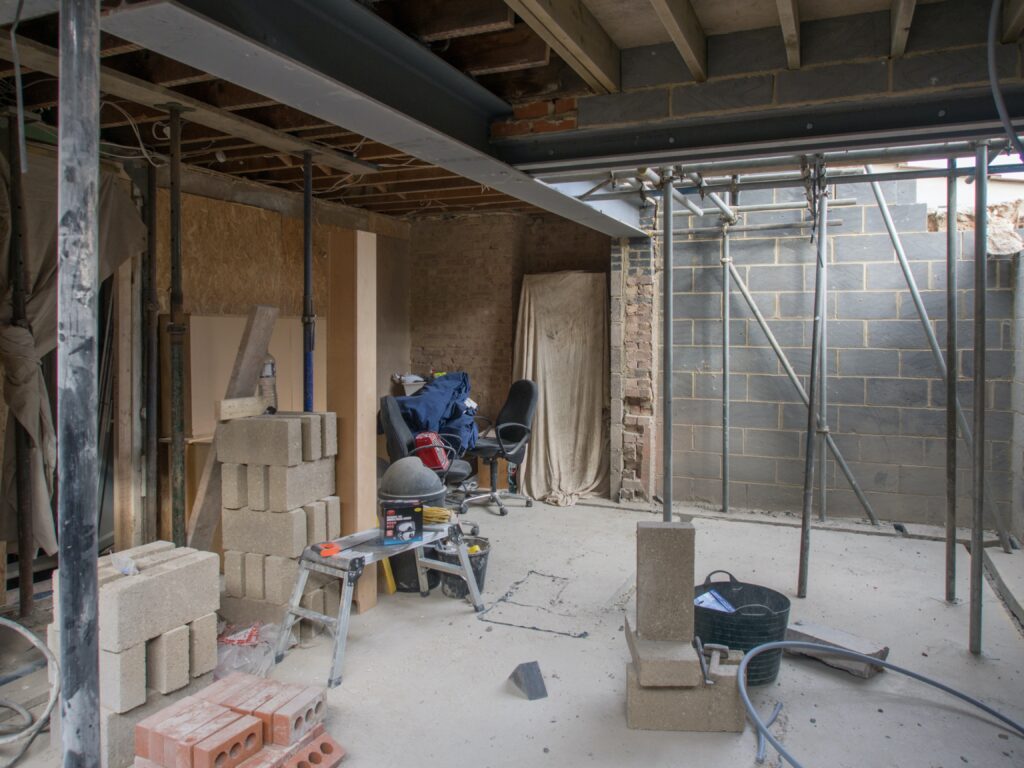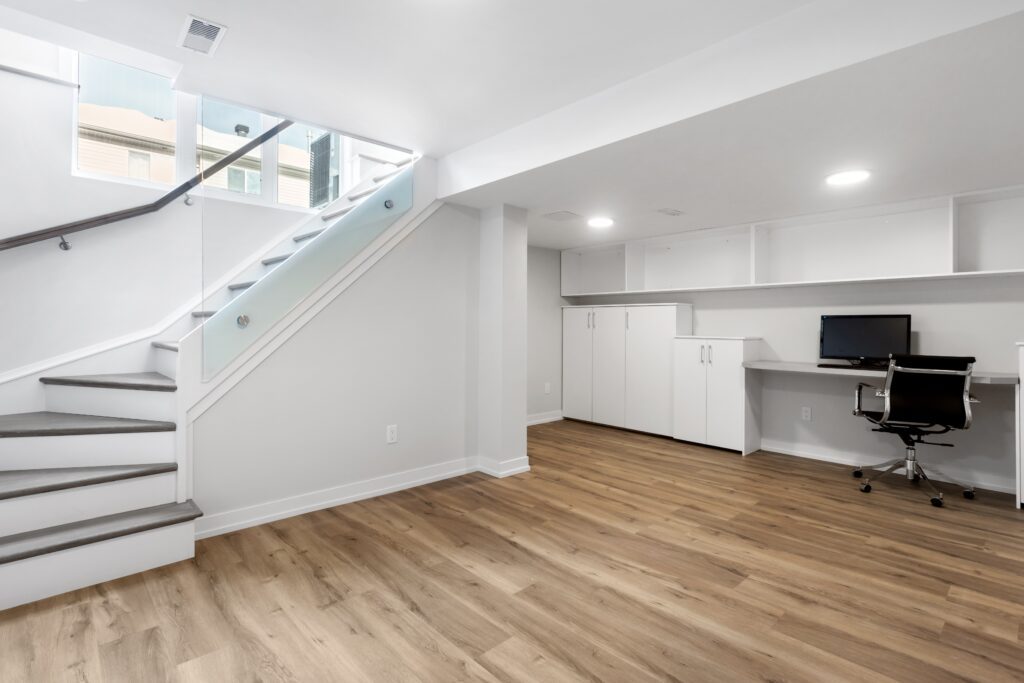Most basements can be converted into a bedroom or additional living space, but not all cellars are set up for a conversion to be worthwhile.
Building codes vary slightly depending on the jurisdiction you live in, but you’ll generally need to ensure the basement is waterproof, well-insulated, has sufficient head room, and has good access before a legal conversion can be done.
However, provided your basement is up to code, a conversion is an excellent home improvement project that can create a private, unique living space that adds value to your home.
At Candid Home Design, we’re often asked what’s possible when it comes to basement conversions, including what the main code requirements are, whether you need a permit, and how to make the most out of your downstairs space.
Keep reading to learn more about the anatomy of a basement conversion and whether your basement can be converted.
Can your basement be converted?
Basement conversions are usually one of the more complicated interior remodel projects (especially compared with garage conversions). You may be able to convert your basement into legal living space, but it must meet a stringent set of local building codes.
Because the requirements are tricky to meet, not all basements can be converted for an affordable, worthwhile price.
The exact requirements can differ slightly depending on the jurisdiction you live in, but you’ll usually need to meet three main aspects for a basement conversion to be considered legal:
- Adequate headroom
- A suitable staircase and egress (or space to add new stairs/egress points)
- Proper insulation in the walls, and potentially in the floor
Provided your basement has the above three things, it’s likely a good candidate for a conversion.
Remember, a good conversion starts with a good design. Even smaller spaces can be converted into a bedroom with enough livable space if you get the design right. Consider working with a designer to see what potential your basement has.
A good designer can work with small, hard-to-picture spaces (including those with low beams and ducts) to create a pleasant, usable room in your home.
What are the Regulations for Converting a Basement?

1. Adequate headroom
The most important thing your basement needs to be suitable for conversion is adequate headroom. As a minimum, your basement must have at least 6 ft 8 inches between the floor and the ceiling after finishings are installed.
Bear in mind that the addition of insulated walls, new flooring, and/or a new ceiling will reduce the amount of headroom you have in the basement. This can lead to your basement not being up to code once all the finishings are installed.
Depending on which jurisdiction you’re in, there may be exceptions for low clearance on ductwork and beams, but the requirements are tricky to navigate. A good designer can help you manage the regulations and suggest a solution that works best for your basement and budget
2. Suitable stairs
Few existing staircases in basements meet current building codes for a conversion. This is because they are often constructed of poor materials with little to no insulation; they also rarely have the required head room, clear width, and tread/riser dimensions. It’s common for stairwells to need to be rebuilt during a basement conversion to ensure they meet local codes.
Depending on local codes, new staircases may be able to be rebuilt to fit in the existing opening, but occasionally they need to be totally reframed to accommodate the required dimensions. This reduces the available space in the basement and can also require reframing the floor above, reducing the square footage of the ground floor in the main part of the house (and taking out valuable floor space in rooms above).
3. Proper insulation
For your basement conversion to be legal – as well as comfortable and liveable – it needs to have adequate insulation. Most jurisdictions require furring walls (framed stud walls with insulation) to be installed between the new living space and the existing foundation walls.
These types of walls can take up a surprising amount of space, so be sure to factor in the reduced size when planning how much finished room area you’ll have. 2×4 furring walls may be allowed in some locations, 2×6 in others; be sure to check with your local permit office.
Additionally, your basement should be dry and well-waterproofed before interior walls can be installed. If your basement is prone to leaks and flooding, waterproofing methods can be expensive.
The most cost-effective way to waterproof a basement involves rolling or spraying a liquid waterproof barrier on the inside of the existing perimeter walls; note that this solution is not always acceptable to a permit office, though. More extensive waterproofing may be required, such as digging around the exterior of the home to apply waterproofing at the exterior of the basement walls, or sometimes trenching the slab around the perimeter at the interior to direct water to a sump pump. A contractor can advise on the best solution for your particular basement and what the estimated costs will be.
What Does My Basement NOT Need to Be Converted?

1. Windows
It’s a common myth that basement conversions require windows, but this isn’t true. Provided your basement conversion has adequate mechanical ventilation (i.e., the supply and return of air) and artificial lighting, there’s no requirement to install a window in a basement living space.
However, if you’re planning on creating a legal bedroom in the converted basement, you WILL be required to add exterior egress from that room. This can be an adequately-sized window with a window well, or an exterior staircase leading from the new bedroom to ground level above.
In order to determine for sure whether your basement can be converted into a legal bedroom, you’ll need to check with your local permitting department to find out the exact rules in your area. You can also give our friendly team at Candid Home Design a call for advice.
2. Finished Ceiling & Floors
To convert a basement, you need to install proper framed walls with adequate insulation and ventilation. However, you don’t have to install a new ceiling or floor to replace what already exists in the basement.
Codes state that insulation is (typically) only needed between unfinished and finished spaces, so provided any ground floor rooms above the converted basements spaces are finished, there’s no need to install ceiling insulation or even a ceiling finish.
In fact, many people choose to make exposed joists or ductwork a design feature of the basement – do a quick Google search for “industrial interior design” and you’ll see exactly what we mean. Granted, most peoples’ basements won’t have Instagram-worthy high ceilings and full-height windows; so if your exposed features are of the less-aesthetic variety, a thin layer of drywall can make your converted basement look and feel a little more finished.
Flooring also is not typically required for a basement conversion; there’s usually nothing wrong with leaving the existing concrete slab exposed or simply finished with carpet, hardwood, or laminate (as long as you put a waterproof barrier below).
If you do choose to install a framed floor, you may be required to install insulation in the joist bays, where floor insulation without a framed floor would not require it. Also keep in mind: head clearances are measured from finish to finish. So, any finished floor or ceiling will reduce the required headroom in the basement, and could mean your conversion no longer meets the minimum requirements.
3. Partial Conversions
Partial conversions of a basement are usually allowed, but many jurisdictions will require a fully heated and insulated space between the existing rooms and the newly converted spaces. For example, if your converted space will have a bedroom and an unfinished basement area, there must be a finished hallway from the stairs to the new bedroom, and insulated walls and a door separating the unfinished area.
However, there may be some exceptions, especially if you’re planning to creating just a finished bathroom in an otherwise unfinished basement. Check your local building codes or speak with a designer to learn more about what’s required in your area.
It’s important to remember that these codes also refer to basement access. A partial conversion without an interior staircase may only allowed if the basement will be converted into a separate legal apartment (classified as a secondary dwelling or ADU – also known as an Accessory Dwelling Unit).
Otherwise, you’ll likely need to install an interior staircase between the existing and new spaces, or build an addition over a new exterior set of stairs to create a fully heated/finished access between the main floor and converted basement.
Are Basement Conversions Worth It?
Basement conversions are well worth it if extra space is needed in a property or if you’re looking to add a boost to your resale value.
Once completed, they can add 10-15% to your property’s value, depending on the square footage and additional features (like whether it has an ensuite bathroom or a window).
However, it’s important to bear in mind that basement conversions aren’t always cheap. To create a functional space, you may need to relocate structural beams, utilities, ductwork, furnaces, or pipes.
A good designer can plan a basement conversion using the existing structure as best as possible, but they can’t work magic to ensure the remodeling project meets your budget.
Less expensive solutions exist, like raising existing beams into the floor system or relocating branch ductwork to the perimeter, but some solutions will require trenching slabs and cutting into foundation walls, which can be costly.
You may have trouble developing a fully clear idea of what changes need to be made in your basement before your dream conversion can be achieved ahead of time. The best way to get a sense of the feasibility of your project is to get a designer involved. Be prepared to invest some money into the planning phase before finding out the total cost of your basement conversion; many of those construction costs will be based on which changes will be required to bring your basement up to code.
It’s also important to keep in mind that a basement conversion will almost always still feel somewhat like a basement. Investing more into your remodeling project (to install more window wells, finished ceilings, and nicer flooring) can make a huge difference in the quality of your conversion, and add a bigger punch to your ROI.
Keep your expectations realistic, though, and remember that investing more into a basement conversion may not necessarily offer a higher return.
Want to know if your basement is a good candidate for a conversion? Schedule a consultation with our friendly design team at Candid Home Design today!




